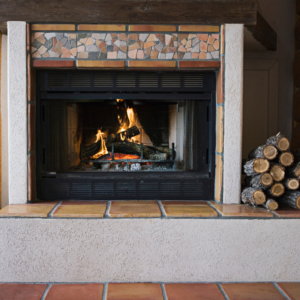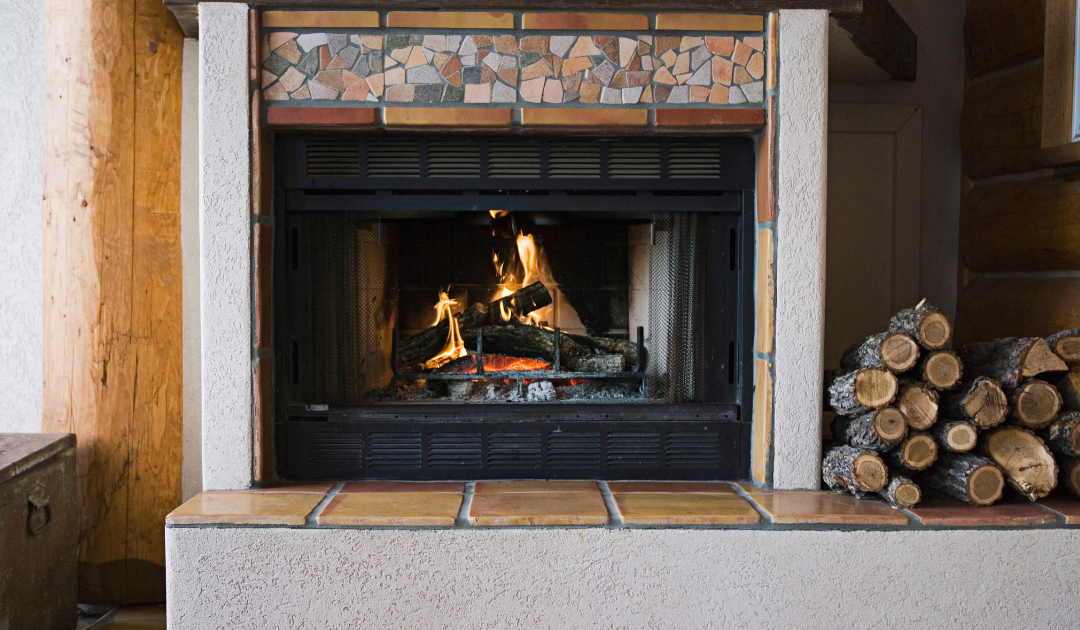Are you looking for greater heat output from your fireplace system or wanting to update a fireplace that looks a little tired? A major construction job doesn’t have to be in your future to achieve your goals. Rather than rebuilding, a fireplace insert can be retrofitted into your existing firebox to introduce the upgrades you desire – with minimal disruption.
When you consider an update, you’ll find you have some options to choose from in terms of appearance and function. One of the first decisions that will present itself is whether you should use a gas or wood fueled fireplace insert.
Gas Fireplaces Offer Convenience & Efficiency
Gas inserts have a lot going for them. For instance, with a gas fireplace, starting your fire only involves the flip of a switch. And when it’s time to go, there’s no waiting for the flames to burn down and embers to cool. Just flip it off, and you’re all set.
 Convenience: The convenience factor of gas is significant, and it extends from prep to clean up. In addition to the ease of use during the fire – no effort building or starting it, and no adding fuel to maintain the blaze – you won’t need to secure firewood to prepare for or scoop ash after your fire, either. Also, many models allow you precision control over the heat output of your fireplace.
Convenience: The convenience factor of gas is significant, and it extends from prep to clean up. In addition to the ease of use during the fire – no effort building or starting it, and no adding fuel to maintain the blaze – you won’t need to secure firewood to prepare for or scoop ash after your fire, either. Also, many models allow you precision control over the heat output of your fireplace.- Easy Maintenance: Maintaining a gas insert is relatively simple too. There’s very little clean-up involved and no tools or firewood to store. Having your gas burner, controls venting inspected and swept annually by an industry professional and completing any of their maintenance recommendations is basically all it takes to keep your fireplace and chimney in ship-shape.
- Efficiency: Gas fireplaces shine in efficiency, as well. While efficiency may vary by model, gas fireplaces are designed for maximizing it – ensuring all that cozy heat gets transferred into your home.
- Environmental Factors: Gas units, while fueled by a non-renewable resource, do have the added environmental advantage of producing almost no smoke or particulate matter. And because smoke and embers aren’t involved, gas fireplaces are often considered safer to use than their wood-fueled counterparts.
Any Downsides?
While gas fireplaces are convenient and run with over 90 percent efficiency, keep in mind that there are fuel costs involved. Typically, the cost of fuel per use of the fire is higher than with a wood fireplace, although the difference is not substantial. Also, if you don’t have a gas line where your fireplace is, remember that you’ll have to have one run to the room.
Wood Fireplaces Produce Ambiance & Warmth
When you go with a wood insert, your fireplace will operate basically the same as an open hearth system in terms of starting, fueling, and maintaining a fire. You’ll purchase or cut firewood, ensure that it’s properly cured and stored, and build a fire using wood and matches. While this requires more effort than simply flipping a switch, for many the art of building a fire is part of its charm.
 Controllable Heat: While it may not be regulated with controls that allow fine temperature precision, it’s still possible to influence heat output from your wood burning fireplace by considering wood species used as fuel and ensuring your firewood is properly dried.
Controllable Heat: While it may not be regulated with controls that allow fine temperature precision, it’s still possible to influence heat output from your wood burning fireplace by considering wood species used as fuel and ensuring your firewood is properly dried. - Economical Heating: For those with ready access to firewood, fueling a wood fireplace or stove is an extremely economical way to heat a home. And wood inserts, while generally not quite as efficient as gas, are still engineered for efficiency and give a generous heat output. As a bonus, wood is a renewable resource.
- Traditional Ambiance: Finally, while gas fireplaces have made great strides toward providing a similar ambiance to a traditional wood-fueled fire, many fireplace users feel there is really nothing quite like the smell, crackle, and feel of relaxing in front of a wood fireplace.
And the Downsides?
Burning a fire with wood is a messier process than with gas. More smoke and soot will be involved, and the firebox will need to be cleared of ash regularly. And the environmental impact is greater with wood than gas too – although new wood inserts release far less smoke and fewer emissions than older models or open fireplaces.
As with gas inserts, you’ll need to have a professional chimney sweep inspect and sweep your chimney annually.
So… Which Is Better?
Both gas and wood fireplaces add value to your home and offer many distinct advantages. Instead of asking which is better, consider which better meets your needs and suits your lifestyle.
Do you have a busy household or love the idea of enjoying a fire with minimal maintenance? The cozy convenience of gas might hold great appeal.
Crave the traditional atmosphere created by logs popping in the fireplace? A wood-fueled appliance may be the better option.
Essentially, either type of fireplace will contribute to the ambiance, warmth, and comfort of your home. Ultimately, the decision boils down to personal preference.
Can I Burn Wood in a Gas Fireplace?
While the choice between wood and gas is up to you, you do have to pick one fuel source and stick with it. No fireplace can use gas and wood interchangeably.
Wood and gas units are engineered to host their own respective fuel type exclusively. Attempting to burn something not intended for use in your firebox is hazardous, increasing risk of uncontained fire and improper ventilation. This means likely damage to your fireplace and/or home, and the danger of harmful fumes and smoke in your living space.
Never ignore the intended fuel and method of using your fireplace.
Call Us for Options
Have your heart set on a fireplace upgrade? Regardless of what type of fuel source you pick, we’re here to serve you. Our skilled staff can explain what products are available and suitable for your space, what the installation process will be like, and how your chimney system should be maintained for optimal benefits.
Find out what exciting possibilities are out there today by reaching out online or giving us a call at 636-303-1459 today.


Recent Comments